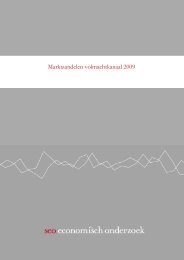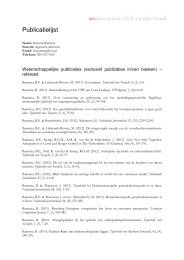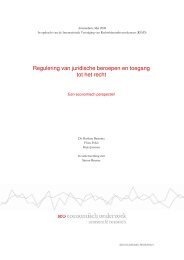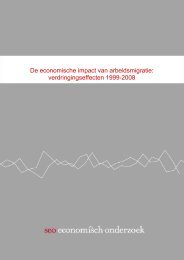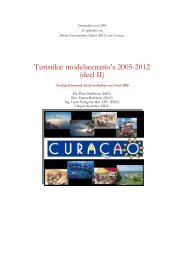Figure 4-1: Unemployment per education level in the <strong>Amsterdam</strong> region (%)Source: Calculated from O+S <strong>Amsterdam</strong> (2008e) (working-age individuals available for labormarket, <strong>Amsterdam</strong> region, figure for 2007), (unemployed, <strong>Amsterdam</strong> metropolitan area, figurefor 2008)Notice that some (temporary) unemployment will always be present, because that goes withchanging jobs or getting a first job. Although more factors influence unemployment rates, it isclear from Figure 4-1 that there is an inverse relation between unemployment rates and educationlevels. From the perspective of the (regional) performance of higher education institutes, thefigure can be interpreted in more than one way. First, getting a higher education degree meansgood labor market prospects. So the institutes seem to be doing a good job. However, theworking-age individuals available for the regional labor market may have gotten their educationin another region. In the <strong>Netherlands</strong>, information on the career trajectories of WO and HBOgraduates is poorly available (OECD, 2008d: 32).Second, not getting a higher education degree implies worse labor market prospects. Theunemployment rate in the group of people with only primary education is ten times as large as inthe group of people with tertiary education. Here, there is evidently an imbalance. In the figure,people should move to the right: more people should get education levels higher than basiceducation. Participation in higher education, in other words, should increase. The OECDmentions increasing the number of secondary school students who go on to university and otherhigher education institutes as one way of making better use of knowledge and skills in theRandstad area (OECD, 2007a: 133). Ethnic minorities are underrepresented in tertiary education(OECD, 2007a: 150). For example, over the period 2006-07, 25- 29% of the population(depending on the precise area) consisted of non-Western foreign Dutch nationals (allochtoon),while 17% of all people who got their higher education diploma were non-Western foreign Dutchnationals (Statistics <strong>Netherlands</strong> Statline, 2009d).For the past 30 years, the population dynamics of large cities in the <strong>Netherlands</strong> (including<strong>Amsterdam</strong>) have been characterized by suburbanization and urban sprawl. Increasing welfareand declining transportation costs are the driving forces behind this process. What also hascontributed to suburbanization are the often crowded housing markets of cities, as a result ofwhich housing prices are driven up. Fewer people will then be able to afford housing. <strong>Amsterdam</strong>in particular faces this problem severely. One of the byproducts is the development of a divided84
housing market, on the ‘buying market’ housing prices are upwardly moving – thereby drivingpotential buyers off the market – whereas on the ‘renting market’ students as well aseconomically and socially disadvantaged groups queue up for cheap social housing.Due to the above phenomena the growth of the city population is lagging behind that of suburbanareas. On the medium to long term this implies that employment will shift to the suburban areasas well, since evidence indicates that employment follows population development and not viceversa (Janssen et al., 2006: 20-23). Moreover, suburbanization and urban sprawl are selectivebecause they apply to the relatively well-off, leaving the economically and socially disadvantagedgroups in the cities. A disproportionate share of the economically and socially disadvantaged isconstituted by minority groups with a non-Western origin (non-Western foreign Dutch nationals).Not surprisingly therefore is that <strong>Amsterdam</strong> has a higher than average share of non-Westernforeign Dutch nationals compared to the rest of the <strong>Netherlands</strong> and that this group on averagefaces higher unemployment rates. Hence, whereas in the <strong>Amsterdam</strong> region the share is 25-29 %(depending on the exact region), the Dutch average is around 11 %. In the <strong>Netherlands</strong> as awhole, the share of people aged between 15 and 65 who are receiving social benefits is 14.3% fornative Dutch nationals and 25.2% for non-Western foreign Dutch nationals. In <strong>Amsterdam</strong>,18.1% of native Dutch nationals aged between 15 and 65 are receiving social benefits, whereasfor non-Western foreign Dutch nationals this is 26.2% (Statistics <strong>Netherlands</strong> Statline, 2005c).Good labor market prospects are one side of the story. The other side is how easy it is forbusinesses to recruit the labor they need. The European Cities Monitor 2008 (Cushman &Wakefield, 2008) gives information on business location decisions. In 2008, <strong>Amsterdam</strong> rankedfifth in terms of recruiting qualified staff (of 34 cities in Europe, including Instanbul). So also inthis respect the HEIs seem to be doing well, with again the qualification that the working-ageindividuals available for the labor market may have gotten their education in another region.Also, in the short and medium run the demand for tertiary education may be larger than supply,especially concerning technology, teaching and health care (Jonge and Berger, 2006: 23-24). TheOECD mentions that labor shortages are to be expected because of the aging of society and alsobecause of a weak labor market participation of notably single parents, low-skilled women,partially disabled persons and inactive migrants (OECD, 2008c). None of the proposed solutionsspecifically involves institutes of higher education. The impact of early tracking and ofinflexibility between tracks on the educational attainment of immigrants’ children is said to beadverse (OECD, 2008a: 56, also see Elk et al., 2009).4.3 Localising the learning process4.3.1 Interaction between HEIs and regional needsIn general, in the <strong>Netherlands</strong> private education institutes are more demand-driven than publicinstitutes. UAS are directed more towards the regional labor market than research universities,given that the latter aim for a more generalist preparation and research. At the same time, UAShave a lower intensity of doctoral training among their staff (OECD, 2008a: 33). The downside ofUAS’ local employment connections is a lower national, European and global connection(OECD, 2008a: 64). According to the OECD public authorities in the <strong>Netherlands</strong> have failed tocreate a policy framework in which tertiary education institutions can fully exploit autonomythrough innovation and client-oriented specialization (OECD, 2008a: 34). For example, the socalled‘macro-effectiveness test’ (macro-doelmatigheidstoets) gives institutes less control over(local) programmes. Hence, regional links are limited to begin with. Platform Arbeidsmarkt enOnderwijs (PAO, platform labor market and education) is a public-private partnership that strivesfor well-functioning labor markets in the <strong>Amsterdam</strong> region (PAO, 2009). Especially themunicipality and the business sector seem to be active in the platform. VU University <strong>Amsterdam</strong>for instance is not a partner. PAO’s focus is more on primary and secondary education than onhigher education, because imbalances are more obvious at the lower levels of education.85
- Page 1 and 2:
Please cite this paper as:SEO Econo
- Page 6 and 7:
2.3 Higher education and the labor
- Page 8 and 9:
6.3 Mechanisms to promote regional
- Page 10 and 11:
Table 4-4: Completion rates of diff
- Page 12 and 13:
LSCA Life Sciences Center Amsterdam
- Page 14 and 15:
such as regional authorities and th
- Page 17 and 18:
1. OVERVIEW OF THE REGION1.1 Introd
- Page 19 and 20:
the southEastern part of Amsterdam
- Page 21 and 22:
elatively bad accessibility of the
- Page 23 and 24:
metropolitan area exceeded that of
- Page 25:
egion suffer from one of the follow
- Page 28 and 29:
Figure 1-7: Dropouts secondary educ
- Page 30 and 31:
Figure 1-9: Employment in Amsterdam
- Page 32 and 33:
high-tech sectors is relatively hig
- Page 34 and 35:
1.4.4 Labor market indicatorsTable
- Page 36 and 37:
The central government is responsib
- Page 38 and 39:
implemented. There is also an admin
- Page 41 and 42: 2 CHARACTERISTICS OF THE HIGHER EDU
- Page 43 and 44: Source: MinOCW (2007a: 68), EU (199
- Page 45 and 46: (ibid: 83). In part, this new syste
- Page 47 and 48: Table 2-1: Student enrolment at UAS
- Page 49 and 50: Figure 2-5: Students at universitie
- Page 51 and 52: Figure 2-6: Participation in tertia
- Page 53 and 54: also show a continued high demand f
- Page 55 and 56: not receive funding from the govern
- Page 57 and 58: of diplomas awarded and the number
- Page 59: decision is up to the HEI itself. I
- Page 62 and 63: Figure 3-1: Components of an innova
- Page 64 and 65: 3.2.3 National funding frameworkThe
- Page 66 and 67: challenge for the years to come wil
- Page 68 and 69: Figure 3-3: R&D expenditures in Noo
- Page 70 and 71: Amsterdam Topstad programme.Creativ
- Page 72 and 73: 3.5.3 Life SciencesGiven the high l
- Page 74 and 75: Figure 3-4: Employment in Amsterdam
- Page 76 and 77: years. Employment in the trade and
- Page 78 and 79: employment has no upward or downwar
- Page 80 and 81: and more efficient exploitation of
- Page 82 and 83: mostly happens in the context of R&
- Page 84 and 85: income related to IP rights. The fa
- Page 86 and 87: Figure 3-6: Regional innovation sys
- Page 88 and 89: HEIs to play this role, as it draws
- Page 91: 4 CONTRIBUTION OF TEACHING & LEARNI
- Page 95 and 96: transport, finance, financial manag
- Page 97 and 98: HvA participates in several initiat
- Page 99 and 100: 4.4 Student recruitment and regiona
- Page 101 and 102: 4.4.1.2 Recruitment of foreign stud
- Page 103 and 104: • HvA has made its educational pr
- Page 105 and 106: The HEIs have several external and
- Page 107 and 108: Table 4-4: Completion rates of diff
- Page 109 and 110: 4.7 Enhancing the regional learning
- Page 111 and 112: 4.8 ConclusionTable 4-6: SWOTStreng
- Page 113: Amsterdam is matched by a relative
- Page 116 and 117: The challenge for future social pol
- Page 118 and 119: The VU likewise develops research p
- Page 120 and 121: directing, documentary directing, s
- Page 122 and 123: the university to improve its energ
- Page 125 and 126: 6.1 Introduction6 CAPACITY BUILDING
- Page 127 and 128: Figure 6-1: Organization chart Vrij
- Page 129 and 130: There are also examples of more spe
- Page 131 and 132: Box 6-2: Obstacles for collaboratio
- Page 133 and 134: eyond labor market studies, there a
- Page 135 and 136: 7 CONCLUSIONS: MOVING BEYOND THE SE
- Page 137 and 138: …requires different forms of coop
- Page 139 and 140: at higher levels in order to mainta
- Page 141 and 142: to increase the interaction between
- Page 143 and 144:
mobility in the world is slackening
- Page 145 and 146:
ecause they are better informed abo
- Page 147 and 148:
REFERENCESAalders, R., A. Bakkeren,
- Page 149 and 150:
EZ Amsterdam (2006), “Research Bu
- Page 151 and 152:
MinOCW (2007a), “The Education Sy
- Page 153 and 154:
SER (2008), “Duurzame Globaliseri
- Page 155:
Versleijen, A., van der Meulen, B.,
- Page 158 and 159:
Institution City Type ofHEIANNEX B:
- Page 160 and 161:
Groningenculture)Hogeschool Amsterd
- Page 163 and 164:
ANNEX C: KEY ECONOMIC INDICATORSTab
- Page 165 and 166:
ANNEX E: REGIONAL PARTNERSHIPS OF A
- Page 167 and 168:
AmsterdamUniversity CollegeOther re
- Page 169 and 170:
ANNEX F: BUSINESSES REPRESENTED IN
- Page 171 and 172:
GLOSSARYBologna DeclarationForeign



